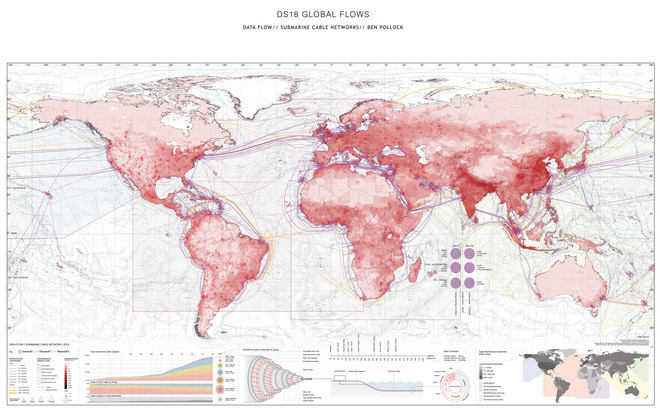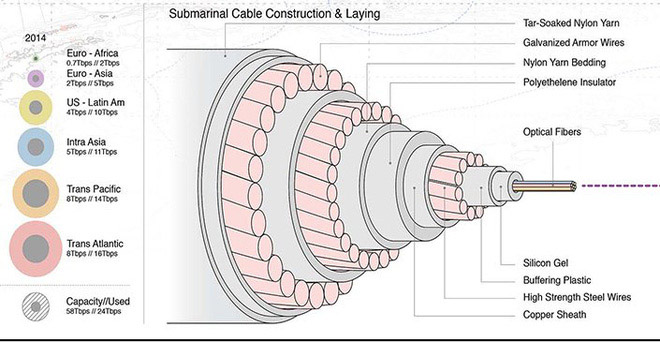Map of 420 Internet cables, stretching 1.1 million kilometers on the seabed around the world
Currently, 99% of global Internet connections are caused by the undersea cable system. Below is a global Internet cable map, along with impressive information about bandwidth and maintenance areas created by Ben Pollock.
Development history of sea cable
In 1858, the first transcontinental sea cable, running from Ireland to Newfoundland was installed. Thanks to that, people can communicate telegrams between England and Canada, although only limited to a few words per hour and very expensive but this is still the fastest speed communication that humans ever had at that time. .

Map of undersea cable lines.
Being able to communicate instantly between two locations far from each other is a miracle and it has caused underground cable to explode. By 1900, more than 200,000 kilometers of cables were installed on the bottom of the ocean.
By 1956, the first transatlantic telephone cables were put into use. And the first fiber optic cable connecting Europe and America also appeared in 1988.

With fiber optic technology, information is transmitted in a large amount, fast and economical. Over time, the continuous transfer rate is increased and the fiber optic cable can transmit 160 terabit per second.

Currently, at the bottom of the oceans around the world, there are more than 420 active underground cables, stretching 1.1 million km connecting every corner of the world whether it is the Arctic Circle or remote Thai islands. Binh Duong. The focus of many cable roads is in areas with a developed information economy like New York and Singapore.
 Structure of a fiber optic cable.
Structure of a fiber optic cable.
Who owns the ocean cable in the ocean?
Typically, cable lines will be owned by private companies or joint ventures established by network operators. But now more and more new cables are built by content providers like Google and Microsoft because of the great demand of cloud computing.
Currently, a number of other methods of providing Ineternet connectivity are also being used by major technology companies such as balloon-mounted satellites or unmanned aircraft.
Ocean cable map video on the ocean floor:
You can visit the link below to view the cable map in an intuitive form.
- https://www.submarinecablemap.com/#/
See more:
- The AAG marine fiber optic cable has a problem, the Vietnam Internet has gone international
- 13 unexpected facts about sea cable routes
- Will the global Internet be broken if all of the undersea cable lines are attacked?
You should read it
- The AAG fiber optic cable has just recovered, APG has a problem again
- The Vietnam Internet will go international on AAG submarine cable to be restored on 9/11
- AAG marine fiber optic cable has a fifth incident in 2017
- Breaking the fiber cable makes a country lose Internet connection for 2 days
- APG fiber optic cable is having trouble, international traffic is reduced by 50%.
- Why are marine optical cables constantly breaking?
- After completing the sea cable line SMW3, the Internet returned to normal
- The recovery of AAG cables must last until October 3
May be interested
- How to Connect to the Internet for a Nintendo Wii
 internet connectivity for your nintendo wii makes it easy to download games, stay up to date with the latest information on nintendo products, and even watch movies and tv shows online on your tv. network connection also helps you challenge your friends to a game even when you are thousands of kilometers apart. follow the steps below to connect your wii to the wireless or wired internet.
internet connectivity for your nintendo wii makes it easy to download games, stay up to date with the latest information on nintendo products, and even watch movies and tv shows online on your tv. network connection also helps you challenge your friends to a game even when you are thousands of kilometers apart. follow the steps below to connect your wii to the wireless or wired internet. - How to Make Battery Cables
 many people jump to blaming their battery when their car, boat, or another machine won't start. but a quick checking of the entire system for corroded or cracked cables, bad connections, or rusty parts, can often reveal issues with the...
many people jump to blaming their battery when their car, boat, or another machine won't start. but a quick checking of the entire system for corroded or cracked cables, bad connections, or rusty parts, can often reveal issues with the... - Distinguish common types of computer cables
 currently there are 10 popular computer cables including: vga cable, dvi cable, hdmi cable, usb cable, ide cable, sata cable, esata cable, firewire cable, ethernet / lan cable, power cable. each one is through a certain interface to transmit the same signal, or signal, sound, image. so what are the characteristics of those 10 cables?
currently there are 10 popular computer cables including: vga cable, dvi cable, hdmi cable, usb cable, ide cable, sata cable, esata cable, firewire cable, ethernet / lan cable, power cable. each one is through a certain interface to transmit the same signal, or signal, sound, image. so what are the characteristics of those 10 cables? - How to Buy Speaker Cables
 you have an incredible speaker system, but now you need to buy speaker cables to finish your audio setup. but, as with many electronic devices, buying the cheapest cable on the market isn't always the best option. you can check your...
you have an incredible speaker system, but now you need to buy speaker cables to finish your audio setup. but, as with many electronic devices, buying the cheapest cable on the market isn't always the best option. you can check your... - The 5 best Cat 8 Ethernet cables of 2024
 whether you need more power for console gaming or need spacious ethernet cables for your server network, cat 8 is the best you can get.
whether you need more power for console gaming or need spacious ethernet cables for your server network, cat 8 is the best you can get. - VNNIC supports to overcome international Internet cable breakdown
 vietnam internet network information center (vnnic) has sent an official letter to internet service providers (isps) to help units respond to incidents caused by aag cable off.
vietnam internet network information center (vnnic) has sent an official letter to internet service providers (isps) to help units respond to incidents caused by aag cable off. - China announced the digital map of Antarctic seabed 3D
 chinese scientists have just published a digital 3d terrain map on the antarctic seabed after collecting data on a recent expedition.
chinese scientists have just published a digital 3d terrain map on the antarctic seabed after collecting data on a recent expedition. - To use the 'clean' Internet, users will have to pay 35 USD / month, are you ready?
 'nothing in the world is free,' this statement is especially true in the internet world.
'nothing in the world is free,' this statement is especially true in the internet world. - We invite you to admire the first 1 million MP photo in the world
 the photographer used 629,370 photos taken by the canon 5d mark iii and canon 65mm mpe lens together to create a photo up to 1,053 terapixel (equal to 1053 gigapixel, equivalent to more than 1 million mp) .
the photographer used 629,370 photos taken by the canon 5d mark iii and canon 65mm mpe lens together to create a photo up to 1,053 terapixel (equal to 1053 gigapixel, equivalent to more than 1 million mp) . - 11 people have changed the Internet world
 the modern internet you are still using everyday is the result of the endless dedication of many people. the wonderful world of the internet has brought great changes to many aspects of human life. the history of the internet began in 1960 and was originally developed to serve research in the fields of science and military.
the modern internet you are still using everyday is the result of the endless dedication of many people. the wonderful world of the internet has brought great changes to many aspects of human life. the history of the internet began in 1960 and was originally developed to serve research in the fields of science and military.










 'Holy' Photoshop transforms dry leaves into landscapes, the lake's shallow water makes many people astonished
'Holy' Photoshop transforms dry leaves into landscapes, the lake's shallow water makes many people astonished Fortnite for Android has a security vulnerability
Fortnite for Android has a security vulnerability Duo, accessories that help laptops have a second screen
Duo, accessories that help laptops have a second screen Vulnerability on macOS helps hackers easily overcome security barriers
Vulnerability on macOS helps hackers easily overcome security barriers New features on Google Play will save your data
New features on Google Play will save your data Google is about to launch Android 9 Pie (Go Edition) for low-end smartphones
Google is about to launch Android 9 Pie (Go Edition) for low-end smartphones